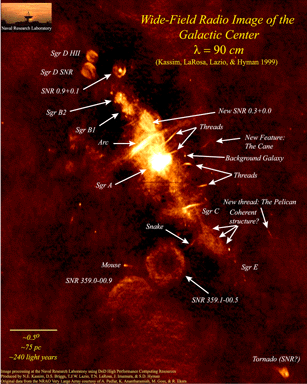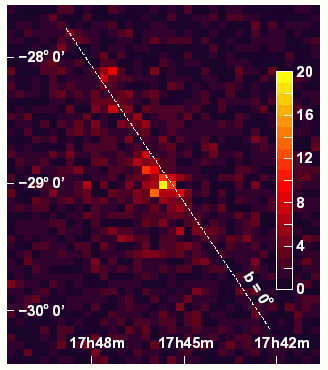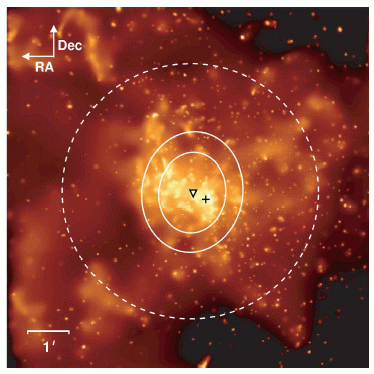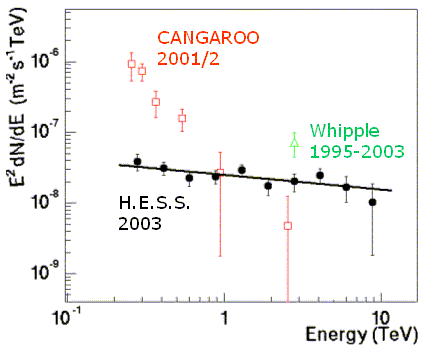The Galactic Center
December 2004

The Galactic Center region harbors a variety of potential sources of high-energy radiation, such as the supermassive black hole Sgr A* and a number of supernova remnants, among them the Sgr A East remnant of a giant supernova explosion which happened about 10000 years ago . Particles of the mysterious dark matter, which accumulate at the Galactic Center and which undergo pair annihilation provide another speculative mechanism for gamma ray production. The Galactic Center was therefore a prime target for observations with Cherenkov telescopes, and detection of high-energy (TeV) gamma rays was reported by the CANGAROO instrument, by the VERITAS group and by the H.E.S.S. collaboration.
In H.E.S.S. data taken towards the centre of our Galaxy (Fig. 1), a strong gamma ray source stands out; in June through August 2003, about 16 h of data were recorded during the commissioning of the telescope system with two telescopes active, resulting in a 11 sigma detection. In summer 2004, with all four telescopes, observations were continued, yielding a 30 sigma detection. The flux corresponds to about 5% of the flux from the Crab nebula. The H.E.S.S. data allow to locate the source with unprecedented precision, with an error of about 30" in RA and Dec (Fig. 2). Within this error, the gamma ray source coincides with the central black hole Sgr A*, but is also consistent with the Sgr A East supernova remnant.
The H.E.S.S. data show a relatively hard energy spectrum of the gamma rays, consistent with a power law with a spectral index of 2.2 (Fig. 3). The spectrum extents to 10 TeV. Flux and spectral index do not exhibit significant variations when comparing two observation periods (June/July and July/August) in 2003, or comparing 2003 and 2004 data. However, the spectrum differs significantly from the very steep spectrum reported by CANGAROO for the years 2001/2.
At this time, the origin of the gamma rays cannot be unambiguously identified. Cosmic ray acceleration by the Sgr A East supernova remnant, followed by interactions of the cosmic rays with the rather dense gas near the Galactic Center could plausibly account for the observed flux and spectrum. Decays of ultra-high-energy neutrons accelerated near the center offer a second mechanism. Alternatively, processes related to the accretion flows and outflows near the Sgr A* black hole have been discussed (see, e.g. here and here). Finally, interpretations in terms of annihilation radiation from supersymmetric dark matter particles or Kaluza-Klein excitations of hidden dimensions were given. The dark matter particles would have to be unusually heavy (> 10 TeV) and quite abundant to explain the measured flux. Data on variability and further improvements in the location of the source will help to identity the origin.
References
Very high energy gamma rays from the direction of Sagittarius A*, H.E.S.S. collaboration, F. Aharonian et al., Astron. Astrophys. 425 (2004) L13-L17


